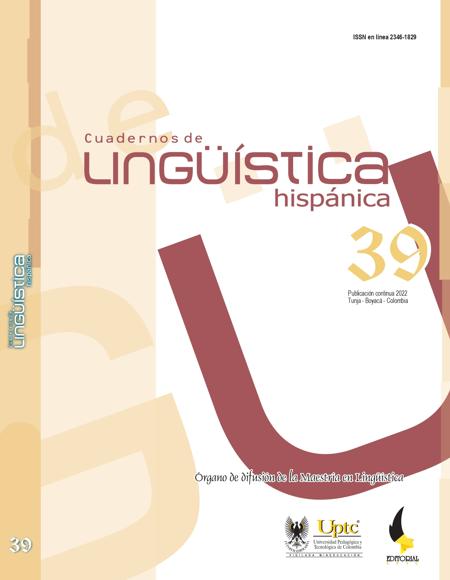Space and Spatiality in the Spanish of the Santander Department: A Proposal for A Regional Dialectal Division

Abstract
This research seeks to integrate social theory into the spatiality analysis of the Andean Spanish of the Santandereano subdialect (Santander department [state], Colombia). The application of a probabilistic methodology allowed the identification of linguistic hierarchical centers, given the impact of population size and geographical and social distance between these localities and the communities within their range of influence. A qualitative analysis stablished the effect of the physical friction of distance on the development of perceptions and values associated with the social environment –an eminently rural space characterized by strong social networks–. Linguistic distance and other factors of resistance such as regional idiosyncrasies reinforce a type of linguistic conservatism that promotes greater distinction between regional varieties. The integration of the spatial dimension through geolinguistics leads the study to advance the proposal for the regional division of this variety.
Keywords
geolinguistics, models of gravity, space, spatiality, hierarchy, social networks, rurality
References
- Andersen, H. (1998). Center and Periphery: Adoption, Diffusion and Spread. In J. K. Chambers, & P. Trudgill (Eds.), Dialectology (pp. 274-331). Cambridge University Press.
- Bradford, M. G., & Kent, W. A. (1977). Human Geography; Theories and Applications. Oxford University Press.
- Britain, D. (2002). Space and Spatial Diffusion. In J. K. Chambers, P. Trudgill, & N. Schilling-Estes (Eds.), The Handbook of Language Variation and Change (pp. 603-637). Blackwell Publishing.
- Bourdieu, P. (1990). The Logic of Practice. Stanford University Press.
- Chambers, J. K. (1995). Sociolinguistic Theory. Blackwell.
- Departamento Administrativo Nacional de Estadísticas -DANE-. (2010). Estudios postcensales. Proyecciones nacionales y departamentales de población 2005-2020. DANE.
- Echeverry, J. C. (2002) Evaluación de la descentralización municipal en Colombia: balance de una década. Departamento Nacional de Planeación.
- Estébanez-Álvarez, J. (1992). Los espacios rurales. En N R. Puyol, J. Estébanez, & R. Méndez (eds.), Geografía Humana (pp. 239-356). Ediciones Pirámide.
- Fotheringham, A. S. (2001). Spatial Interaction Models. In N. J. Smelser & P. B. Baltes (Eds.), International Encyclopedia of the Social & Behavioral Sciences (pp. 14794-14800). Elsevier.
- Fotheringham, A. S., & O’Kelly, M. E. (1989). Spatial Interaction Models: Formulations and Applications. Vol. 1. Kluwer Academic Publishers.
- Gobernación de Santander. (2019). Ordenanza n.° 09 de 2019. Por medio de la cual se crean las provincias administrativas y de planificación de Santander. Asamblea de Santander. https://asambleadesantander.gov.co/mdocs-posts/ordenanza-no-009-de-2019_compressed/
- Gobernación de Santander & Universidad Santo Tomás de Aquino. (2014). Lineamientos y directrices del ordenamiento territorial de Santander. Litografía IRIS Impresores. http://santandercompetitivo.org/ media/6520c93b26bd67d7d5c2f7de83d250c888221c0c.pdf
- Google. (s.f.a). Direcciones de mapas de Google para la distancia entre Bucaramanga y San Gil, Santander. https://www.google.com/searchq=distancia+entre+sangil+santander+colombia+y+bucaramanga
- Google. (s.f.b). Direcciones de mapas de Google para la distancia entre Bucaramanga y Málaga, Santander. https://www.google.com/search?q=distancia+entre+malaga+santander+colombia+y+bucaramanga
- Google. (s.f.c). Direcciones de Mapas de Google para la distancia entre Vélez, Santander y Bucaramanga, Santander, Colombia. https://www.google.com/search?q=distancia+entre+velez+santander+colombia+y+bucaramanga
- Hägerstrand, T. (1952). The Propagation of Innovation Waves. Gleeip.
- Hägerstrand, T. (1966). Aspects of the Spatial Structure of Social Communication and the Diffusion of Information. Papers of the Regional Science Association, 16, 27-42.
- Hägerstrand, T. (1967). Innovation Diffusion as a Spatial Process. University of Chicago Press.
- Hägerstrand, T. (1969). Diffusion of Innovation. University of Chicago Press.
- Hernández Campoy, J. M. (1998). Requisitos teórico-metodológicos para el estudio geolingüístico del dialecto murciano. En J. K. Chambers, & P. Trudgill (Eds.), Dialectology (pp. 274-331). Cambridge University Press.
- Hernández Campoy, J. M. (1999). La geolingüística: consideraciones sobre la dimensión espacial del lenguaje. Estudios de Lingüística, E.L.A.S., 13, 5-88.
- Hernández Campoy, J. M. (2002). Geolingüística: modelos de interpretación geográfica para lingüistas. Universidad de Murcia.
- Hernández Campoy, J. M. (2007-2008). Principios básicos para el estudio geolingüístico de la variación. Estudios Románicos, 16-17, 515-528.
- Hernández Campoy, J. M. (2012). Los modelos de gravedad y la medición de la difusión del cambio lingüístico. Revista de Filología, 30, 83-109.
- Instituto Nacional de Vías -Invías-. (2018). Mapa carreteras de Santander. Mapa vial. Gifex. https://www.gifex.com/America-del-Sur/Colombia/Santander/Carreteras.html
- Milroy, L., & Milroy, J. (1985). Linguistic Change, Social Network and Speaker Innovation. Journal of Linguistics, 21, 339-384.
- Ramírez J, C. & De Aguas P., M. (2016). Configuración territorial de las provincias de Colombia: ruralidad y redes. Cepal. https://www.cepal.org/sites/default/files/news/files/configuracion_territorial_de_las_provincias_de_colombia. pdf
- Rincón, L. M. (2021). Estudio de espacialidad del español rural de Santander (Colombia): contextualización teórica y conceptual. Forma y Función, 34(1). https://revistas.unal.edu.co/index.php/formayfuncion/article/view/81256
- Roa Medina, J. (2009). Tunja, ciudad que emerge. Credencial Historia, (237). https://www.banrepcultural.org/biblioteca-virtual/credencial-historia/numero-237/tunja-ciudad-que-emerge.
- Trudgill, P. J. (1999). Dialect Contact, Dialectology and Sociolinguistics. Cuadernos de Filología Inglesa, 8, 1-8.
- Valdivia López, M., Ávila Sánchez, H., & Galindo Pérez, C. (2010). Fricción de la distancia, autocorrelación espacial de la productividad e impacto de la longitud por carretera en la dinámica de convergencia de la región centro de México (1993-2003). Investigaciones Geográficas, (71), 72-87.
- Wheeler, J. O. (2005). Mathematical Models in Geography. Encyclopedia of Social Measurement, 2, 115-123.
- Wolfram, W., & Schilling-Estes, N. (2003). Dialectology and Linguistic Diffusion. In B. Joseph & R. Janda (Eds), The Handbook of Historical Linguistics (pp 714-1743). John Wiley & Sons.
